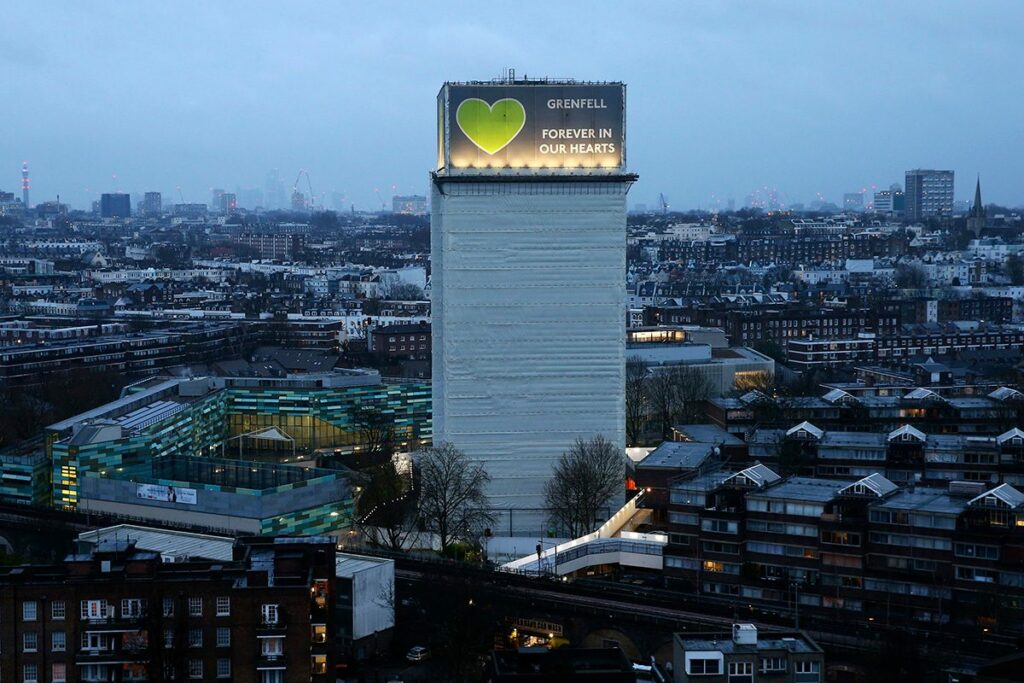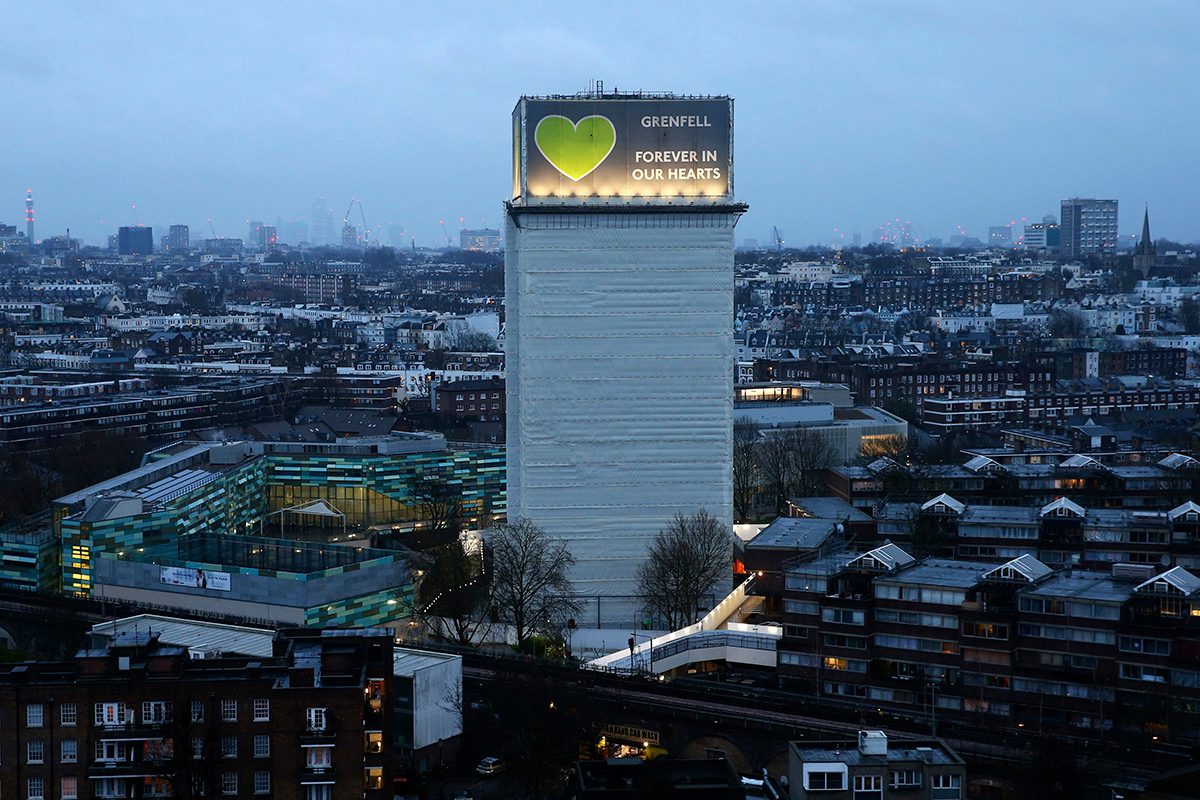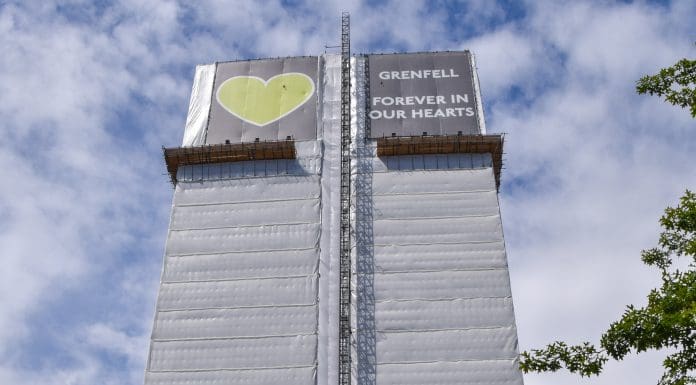Grenfell: Time for a material change

This post was originally published on this site

How on Earth did we forget the lessons of the Great Fire of London? The Grenfell Inquiry’s second phase report presents an answer, laying bare a sordid tale of incompetence, hubris and greed. Tim Clark reports
If you wanted to build a home in Georgian, Edwardian or Victorian London, to a certain extent the rules of what could and couldn’t be used were strict.
The reason for such no-nonsense regulations was simple. In 1666 most of mediaeval London caught fire, destroying swathes of the City of London, including the grand original St Paul’s cathedral.
Vowing to never allow such a fire to happen again, strict building codes were introduced following the passing of the 1667 London Building Act, with surveyors employed to enforce the code. The act itself can still be viewed in the Parliamentary archives.
Although the Act was revised in the centuries that followed, the main principle – that buildings shouldn’t burn or spread fire risk – served London well, especially during WWII when, under Luftwaffe attack, the city was bombed incessantly.
Fast forward another seventy years and the Grenfell Tower disaster is a reminder that to a certain extent, the modern building industry has wilfully forgotten many of the lessons of history; that flammable materials burn, and can do so horrifically fast.
As the industry digests the impact of the recently published second part of the Grenfell Inquiry, many factors, people, and organisations are caught on the web of blame.
However, one main principle can be considered prevalent: If the materials were designed to be suitably fire resistant then would the disaster have happened at all? Second, has the modern construction industry really begun to understand findings the web of blame has been shown to include?
Just how far has the industry come to analyse the materials it uses, and consider whether they are truly justified, is questionable.
Blame game
Among the many agencies, companies and people who were identified as to blame for the underlying causes of the Grenfell fire, the material manufacturers were singled out for particular criticism.
Alex Delin, construction partner at Irwin Mitchell says that the Inquiry reveals just how far such manufacturers are to blame.
“The inquiry found Arconic concealed the extent of the risk its Reynobond 55 PE cladding panels presented, Celotex misrepresented claims to a specialist cladding subcontractor, Harley, about its products such as the RS5000 insulation within the cladding it made, and Kingspan misled the market about its K15 insulation comprising 5% of the insulation used at Grenfell,” he says.
“Kingspan has been more forthcoming about its liability and exposure, and recently is said to have settled a £70m claim Shepherd [Construction] bought at a separate mixed-use project in Colindale. That claim was brought under the Building Safety Act 2022, which has been on the statute books since 28 June 2022 and was introduced to tackle these issues relating to building safety risks.”
Arconic is still facing a shareholder lawsuit in the US over allegations that it misled investors over the risk that its products were unsuitable to be used on high rise buildings.
The Grenfell Inquiry shows just how many questions still remain over how the construction sector allowed unsafe materials to be certified and used at all. The report totalled 1,745 pages and includes over 50 recommendations. Another question is whether there is a wider trend of using unsuitable materials in-build within modern designs.
Such concerns pre-date Grenfell. Research conducted in the United States and published in 2015 looked to test the differences between older and modern building techniques and their impact in the case of a fire.
Underwriter Laboratories (UL) worked with the Chicago Fire Department, Michigan State University and the International Association of Fire Chiefs to evaluate the fire resistive performance of nine structural assemblies, including seven floor-ceiling constructions and two roof-ceiling constructions.
Fire testing was conducted in accordance with ASTM International’s E119 (a global technical standard), but structural loads were altered to better reflect actual conditions during a fire. Testing results for individual assemblies were then analysed and compared with the testing results of other assemblies.
In its report UL stated that “the results of testing conducted under this study showed that the fire containment performance of an assembly supported by solid joist construction was better than an assembly supported by an engineered I-joist”.
THe UL research was one study, and should be noted was in a different jurisdiction than the UK. However with widespread criticism of the Building Research Establishment (BRE) in the Grenfell Inquiry findings, perhaps a more comprehensive and robust safety testing regime needs to be put in place.
It is not only the raw construction components that can add to the fire risk of a building. A video from 2010 by the National Institute for Standards Testing shows the visual difference between a modern room and a “legacy” room, which has been decorated with the older furnishings.
It’s important to point out that the materials used in the test aren’t known, but are they, however, indicative of a modern home and how quickly it burns?
The timeline for the fire at Grenfell showed that at 00:54am Behailu Kebede called 999 to report a fire in flat 16, on the fourth floor. A mere 15 minutes later, at 1.09am the fire had broken out of the flat and begun climbing the exterior cladding, with disastrous results.
If modern furnishing adds to the overall fire load of a building, then do the structural components need to be even more fire resistant to compensate for this extra risk?
Culture change
Another aspect of the report is that people without expertise in handling certain construction schemes were appointed, in the case of Grenfell without competitive tender, as was the case for architect Studio E, which won the refurbishment work even though it hadn’t worked on buildings as tall as Grenfell previously.
“Clients need to ensure that works are not awarded to the lowest cost contractor, but to the most competent and capable companies that take quality, safety and risk seriously,” says John Ryan, chief executive of Symterra.
“The core decision to change cladding (ACM panels as the rain screen and insulation) to value engineer down costs was made without any understanding of the properties of the materials and the significant risks they introduced.”
Commenting on Twitter, the founder of RCKa Architects, Russell Curtis stated that a competent architect would have charged double what Studio E charged for works at Grenfell.
“Yet, even today, there are clients accepting fees of this order for work which should be significantly higher. We’ve not learnt a thing.”
Better training, and especially ongoing training for employees who undertake building operations and maintenance could help ensure that issues are spotted.
In a post analysing the issues with the Grenfell fire, Mehrdad Tavakkolian, vice president of construction innovation at Canadian construction firm Tucker High Rise Inc, says that Grenfell emphasises the critical need for those working in architecture, engineering and construction to be vigilant throughout a building’s life cycle, from design to demolition, of the role that materials and construction methods play on fire safety.
“Operation and maintenance teams play a crucial role in preserving the integrity of fire safety systems. Regular inspections and maintenance of fire alarms, sprinklers, and emergency lighting systems are essential to ensure that they function correctly in the event of a fire,” Tavakkolian says.
“Equally important is the need for building managers to be vigilant about the condition of materials and construction elements that could pose fire risks if compromised or altered.”
Material issue
The introduction to Part 3 of the Inquiry report states that “safety in the built environment depends in a large measure on designers being able to assess with confidence how particular materials and products will behave when incorporated into a building”.
If Grenfell is indicative of the industry at large in 2017 then it is fair to say that the industry failed.
The Grenfell Inquiry was particularly scathing about the role of materials manufacturers such as Kingspan and Arconic in how their products contributed to the speed and scale of the fire spread.
The Inquiry stated: “From 2005 until after the Grenfell Tower fire Arconic deliberately concealed from the market the true extent of the danger of using Reynobond 55 PE in cassette form, particularly on high-rise buildings.”
Other materials manufacturers such as Kingspan and Celotex are similarly found to be at fault.
As the Inquiry report states, by 2013 at the latest, the construction industry knew that Approved Document B was unclear, and not properly understood by a significant proportion of those working in the industry. By February 2016, it had become aware that some in the industry were worried that combustible insulation, and aluminium composite material (ACM) panels with unmodified polyethylene cores, were routinely being used on high-rise buildings in breach of functional requirement B4.
The full impact of the report will take time to assess, and appropriate changes may need further legislation to implement, beyond what has already been seen with new laws such as the Building Safety Act.
One such recommendation, that of the appointment of a construction regulator, could shift the industry away from dangerous materials.
The Grenfell Inquiry can feel like the closing of one chapter in the story of how to make the construction industry safer. The next chapter needs to see action taken on the issues that the Inquiry so poignantly identified.
Read next: Grenfell Inquiry report prompts calls for change
Are you a building professional? Sign up for a FREE MEMBERSHIP to upload news stories, post job vacancies, and connect with colleagues on our secure social feed.





Responses